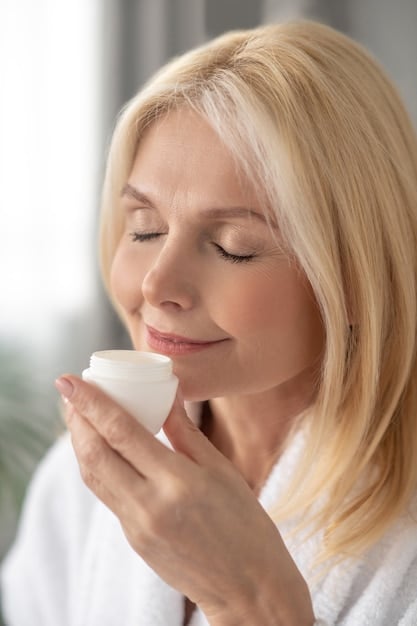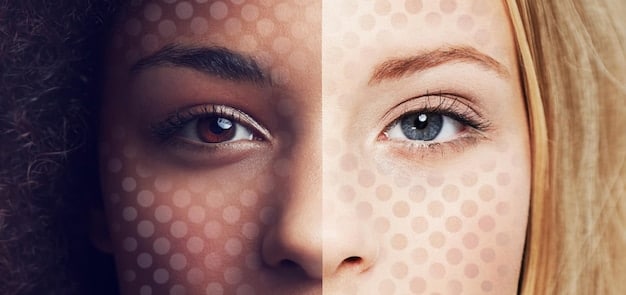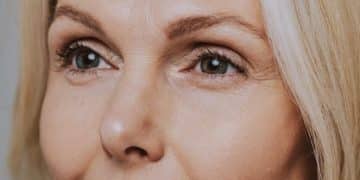The Truth About Anti-Aging Creams: 2025 Guide to What Really Works

The Truth About Anti-Aging Creams: What Works and What’s a Waste of Money in 2025 lies in understanding active ingredients like retinoids, peptides, and antioxidants, while recognizing that claims of instant or miraculous results are often marketing hype. This guide helps you make informed choices.
Navigating the world of anti-aging creams can feel like wading through a sea of promises. Every product claims to be the fountain of youth in a jar, but how much of it is based on real science? Understanding the truth about anti-aging creams: what works and what’s a waste of money in 2025 is essential for making informed choices.
This article will explore the key ingredients that have proven anti-aging benefits, separate fact from fiction, and help you create a skincare routine that truly addresses your concerns. Let’s explore the truth about anti-aging creams that will keep you looking youthful!
The Science Behind Aging: What Really Happens to Your Skin
Before diving into specific creams and ingredients, it’s crucial to understand what happens to our skin as we age. Knowing the underlying processes can help you target your skincare efforts more effectively.
The aging process is multifaceted, encompassing everything from reduced collagen production to environmental damage. By understanding these factors, you can choose products designed to counteract specific issues.
Collagen Loss and Elasticity
As we age, our bodies produce less collagen, the protein responsible for skin’s firmness and elasticity. This decline leads to wrinkles, sagging, and a loss of youthful plumpness.
Environmental Damage and Free Radicals
Exposure to environmental factors like UV radiation and pollution generates free radicals, unstable molecules that damage skin cells. This damage accelerates aging and can lead to dark spots and uneven skin tone.
- Sun damage: The primary cause of premature aging.
- Pollution: Contributes to oxidative stress and inflammation.
- Lifestyle choices: Smoking and poor diet exacerbate aging.

Ultimately, understanding the aging process allows you to select anti-aging creams that address the root causes and provide effective solutions. By knowing what you’re fighting against, you can make better choices about what to use.
Decoding the Labels: Key Ingredients in Anti-Aging Creams
With countless products on the market, it’s easy to feel overwhelmed by the ingredient lists. Knowing which ingredients are backed by science can save you time and money.
Certain ingredients have consistently demonstrated anti-aging benefits in clinical studies. These are the ones to look for when choosing an anti-aging cream.
Retinoids: The Gold Standard
Retinoids, derivatives of vitamin A, are among the most well-researched anti-aging ingredients. They stimulate collagen production, reduce fine lines and wrinkles, and improve skin texture.
Peptides: Building Blocks of Youth
Peptides are short chains of amino acids that act as building blocks for proteins like collagen and elastin. They can help firm the skin and reduce the appearance of wrinkles.
- Copper peptides: Promote collagen and elastin production.
- Matrixyl: Stimulates collagen synthesis.
- Argireline: Reduces muscle contraction, minimizing wrinkles.
The Truth About Anti-Aging Creams: What Works and What’s a Waste of Money in 2025 in the US
Understanding the truth about anti-aging creams: what works and what’s a waste of money in 2025 involves differentiating between scientifically-backed ingredients and marketing gimmicks. For US consumers, regulations and product availability further impact these choices.
In the US market, some products can make unsubstantiated claims due to less stringent regulations compared to other regions. It’s important to discern what’s truly effective from what simply sounds good.
Ingredients To Prioritize
Several ingredients remain consistently effective according to dermatologists.
Retinoids and Retinols
These vitamin A derivatives are proven to boost collagen production, reduce wrinkles, and enhance skin texture. Prescription retinoids are stronger, while over-the-counter retinols are a milder alternative.
Peptides
These amino acid chains help to stimulate collagen production and repair skin damage. They’re often found in firming and hydrating creams, ideal for improving skin elasticity.
- Hyaluronic Acid: Provides hydration and plumpness
- Vitamin C: Works as an antioxidant to protect skin.
- Niacinamide: Reduces redness and pore size
Ultimately, making informed decisions begins with understanding which ingredients have scientific backing and can deliver tangible results when it comes to the truth about anti-aging creams: what works and what’s a waste of money in 2025.

Marketing Hype vs. Scientific Evidence: Spotting the Red Flags
The beauty industry is known for its persuasive marketing tactics. Being able to recognize hype and focus on scientific evidence is crucial for making smart purchases.
Many anti-aging creams rely on buzzwords and exaggerated claims to attract customers. Learning to identify these tactics can prevent you from wasting money on ineffective products.
Unrealistic Promises
Be wary of creams that promise instant or dramatic results. Anti-aging is a gradual process, and no cream can completely reverse the effects of time overnight.
Buzzwords and Vague Claims
Watch out for vague terms like “youth-boosting” or “revitalizing” without specific information about the active ingredients and their proven benefits.
- Look for clinical studies: Check if claims are backed by research.
- Consult experts: Dermatologists can provide valuable insights.
- Read reviews: See what other users have experienced.
Staying informed and skeptical will help you navigate the marketing hype and choose anti-aging creams that truly deliver on their promises. It’s all about focusing on evidence-based ingredients and realistic expectations.
Creating an Effective Anti-Aging Skincare Routine
Choosing the right products is only part of the equation. How you use them and incorporate them into a daily routine is equally important for achieving the desired results.
An effective anti-aging skincare routine involves a combination of preventative measures, targeted treatments, and consistent care. Here’s how to create a routine that works for you.
Daily Essentials
Start with a gentle cleanser to remove impurities without stripping the skin of its natural oils. Follow with an antioxidant serum, a moisturizer, and, most importantly, sunscreen.
Nighttime Treatments
In the evening, focus on repairing and rejuvenating the skin. Use a retinoid cream to stimulate collagen production and address fine lines and wrinkles.
- Morning: Cleanse, antioxidant serum, moisturizer, sunscreen.
- Evening: Cleanse, retinoid, hydrating moisturizer.
- Consistency: Stick to your routine for best results.
By establishing a consistent and targeted skincare routine, you can maximize the benefits of your anti-aging creams and maintain a youthful, radiant complexion. It’s about combining the right products with the right habits for long-term results. Remember, the truth about anti-aging creams: what works and what’s a waste of money in 2025 is about the entire process.
| Key Point | Brief Description |
|---|---|
| ✨ Retinoids | Stimulate collagen, reduce wrinkles. |
| 💧 Peptides | Building blocks for collagen, firm skin. |
| 🛡️ Sunscreen | Essential for preventing premature aging. |
| 🔬 Backed claims | Verify ingredients’ claims; see what works in 2025! |
Frequently Asked Questions
While there’s no magic number, many dermatologists recommend starting in your late 20s or early 30s, focusing on prevention with sunscreen and antioxidants. Addressing the truth about anti-aging creams early can yield longer results.
No cream can entirely erase wrinkles, but consistent use of evidence-based ingredients like retinoids and peptides can significantly reduce their appearance and improve skin texture over time.
Not necessarily. The price of a cream doesn’t always correlate with its effectiveness, and you may find similar ingredients across products of different price points. The truth about anti-aging creams lies in the formula’s backing research.
It varies depending on the product and your skin type, but most active ingredients require at least 4-6 weeks of consistent use to show noticeable improvements. Be patient and persistent.
Heading into 2025, focus on proven ingredients like retinoids, peptides, and sunscreen. Be wary of products with unrealistic claims. Building a routine takes time with consistent research and dedication.
Conclusion
In conclusion, the truth about anti-aging creams: what works and what’s a waste of money in 2025 comes down to a combination of science-backed ingredients, realistic expectations, and consistent skincare habits. By understanding the aging process and the power of key ingredients, and focusing on creams available in the US, you can navigate the market with confidence.
Remember, anti-aging is a journey, not a destination. By making informed choices and prioritizing your skin’s health, you can achieve a youthful, radiant complexion that reflects your overall well-being for years to come.





